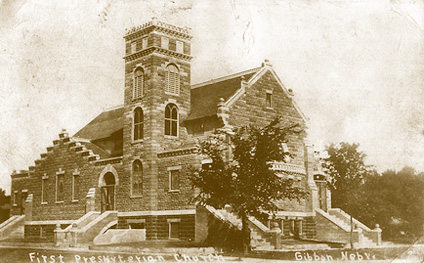
In 1866, a rail siding was built as part of the construction of the Union Pacific Railroad. It was named Gibbon Switch in honor of General John Gibbon. General John Thorpe was originally given the town site of what became Gibbon in exchange for establishing a town site in Buffalo County.
 |
Because of the Indian uprisings in 1864, William and Dinah Nutter abandoned their original homestead on the Wood River in Hall County, just east of where the town of Shelton now stands, and returned to England. They returned to Nebraska in 1869, again settling on the Wood River, this time further west in Buffalo County, near the Gibbon Switch. They purchased "squatter's rights" on this property, on which were a log house and a log barn. The builder and previous owner, William Story had been killed by Indians. They lived in the log house for 18 years.
When they settled again in Nebraska, the Nutter family consisted of William, Dinah and six children, John, William, Ellen, Ione, Elizabeth, and Alice. (3 other children had died as infants, and their youngest, Thomas, died in 1869, on the train as they travelled to Nebraska.) Their remaining children were born on their homestead near Gibbon: Jenny, Frank, Mirabeau, and Louise.
The Union Railroad organized a colony of approximately 85 families from Ohio and other eastern states in the winter of 1870, and planned for the building of homes in the newly established State of Nebraska. Gibbon was also laid out during this time and on April 7, 1871 a settlement commenced. A surveyor by the name of Mr. J.N. Paul helped the colonist by beginning a survey of the town site of Gibbon. This was finished by C. Putnam. The completion of the survey saw the donation of one block for a public school, one block for a courthouse and a site for a church building. All of these sites were donated by the owners. By July, 1872, there would be about 150 families, and all who arrived by this date were considered original members of the Gibbon Colony, also known as the Soldier's Free Homestead Colony of Gibbon, as most of the male members were Union veterans of the Civil War.


In 1891, twenty years after the colonists' arrival, a reunion was held. At the meeting it was decided to gather annually to celebrate the 1871 event and the founding of the town of Gibbon. Those attending included not only the original colonists, but as time went on, their children and grandchildren. The picture below was taken at the reunion in 1907. Though his family preceded the arrival of the colonists in Gibbon, William Nutter, Jr., son of William and Dinah, and his wife Laura attended the reunion, (2nd and 3rd from the left in the back row), as did their niece, Beatrice Nutter, then 15-16 years old, daughter of William's brother John and his first wife Anna (7th from the left in the front row, holding a scarf). (Solomon D. Butcher photographed this reunion. We owe so much to this man, as he captured so many historic scenes and events in the area. You'll find a high-resolution version of his photograph here.)
 |